AMD Ryzen Threadripper 3960X Linux Benchmarks
For this exercise, we are using our legacy Linux-Bench scripts which help us see cross-platform “least common denominator” results we have been using for years as well as several results from our updated Linux-Bench2 scripts. At this point, our benchmarking sessions take days to run and we are generating well over a thousand data points. We are also running workloads for software companies that want to see how their software works on the latest hardware. As a result, this is a small sample of the data we are collecting and can share publicly. Our position is always that we are happy to provide some free data but we also have services to let companies run their own workloads in our lab, such as with our DemoEval service. What we do provide is an extremely controlled environment where we know every step is exactly the same and each run is done in a real-world data center, not a test bench.
We are going to show off a few results, and highlight a number of interesting data points in this article.
Python Linux 4.4.2 Kernel Compile Benchmark
This is one of the most requested benchmarks for STH over the past few years. The task was simple, we have a standard configuration file, the Linux 4.4.2 kernel from kernel.org, and make the standard auto-generated configuration utilizing every thread in the system. We are expressing results in terms of compiles per hour to make the results easier to read:
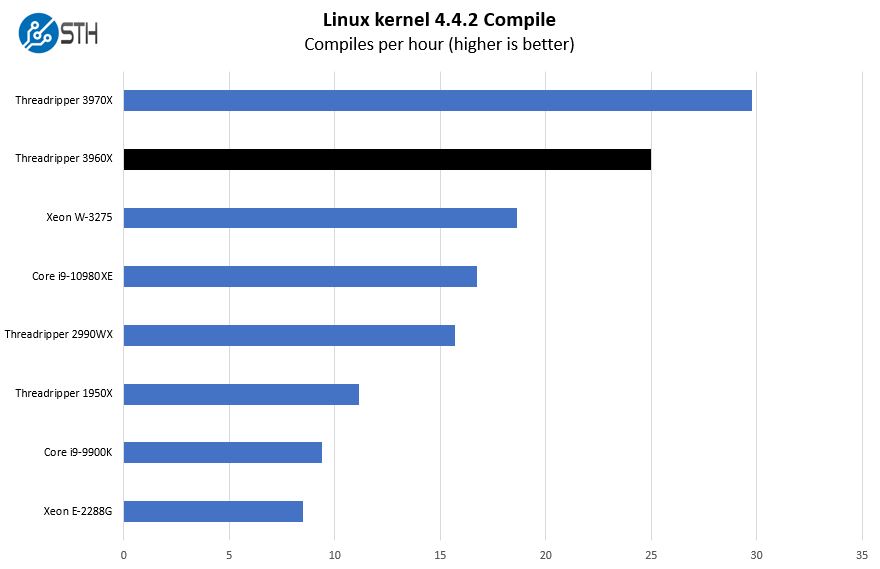
Plenty of single and multi-core performance along with solid memory bandwidth means that the Threadripper 3960X performs very well here.
c-ray 1.1 Performance
We have been using c-ray for our performance testing for years now. It is a ray tracing benchmark that is extremely popular to show differences in processors under multi-threaded workloads. We are going to use our 8K results which work well at this end of the performance spectrum.

This test is similar to some of the Windows rendering tests in that AMD performs very well. Here, the 2990WX is able to best the newer 3960X by a small margin.
7-zip Compression Performance
7-zip is a widely used compression/ decompression program that works cross-platform. We started using the program during our early days with Windows testing. It is now part of Linux-Bench.
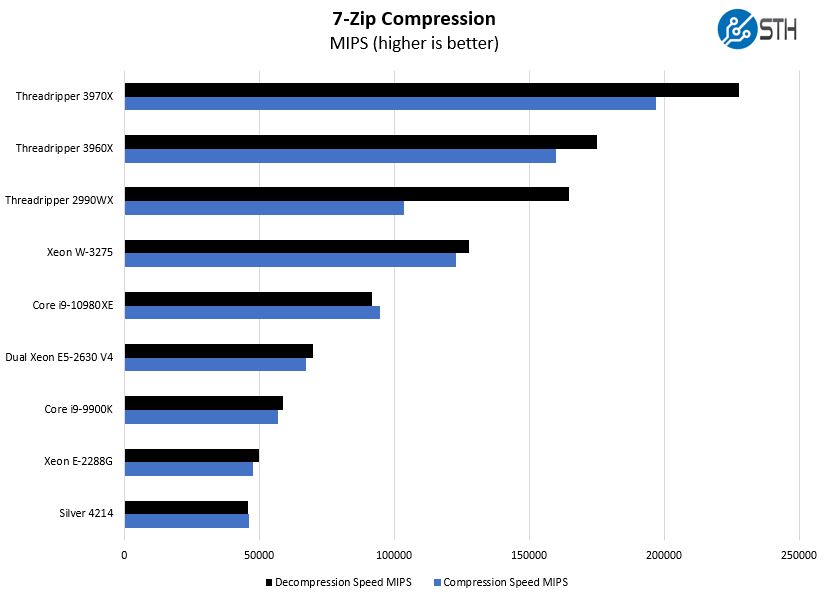
One item to look at here is the decompression/ compression ratio change generationally. With the previous generation Threadripper, the compression speed was much lower than with the current generation. That is an indicator of a major architectural shift.
NAMD Performance
NAMD is a molecular modeling benchmark developed by the Theoretical and Computational Biophysics Group in the Beckman Institute for Advanced Science and Technology at the University of Illinois at Urbana-Champaign. More information on the benchmark can be found here. We are going to augment this with GROMACS in the next-generation Linux-Bench in the near future. With GROMACS we have been working hard to support Intel’s Skylake AVX-512 and AVX2 supporting AMD Zen architecture. Here are the comparison results for the legacy data set:

We added some of our dual CPU results here. Interestingly enough, the Threadripper 3960X actually bested dual Intel Xeon Gold 6242’s in this test. Each Intel Xeon Gold 6242 has 16 cores but spread across two sockets.
Sysbench CPU test
Sysbench is another one of those widely used Linux benchmarks. We specifically are using the CPU test, not the OLTP test that we use for some storage testing.

This is a test where we see fairly straightforward performance stacking based on core counts which makes sense.
OpenSSL Performance
OpenSSL is widely used to secure communications between servers. This is an important protocol in many server stacks. We first look at our sign tests:
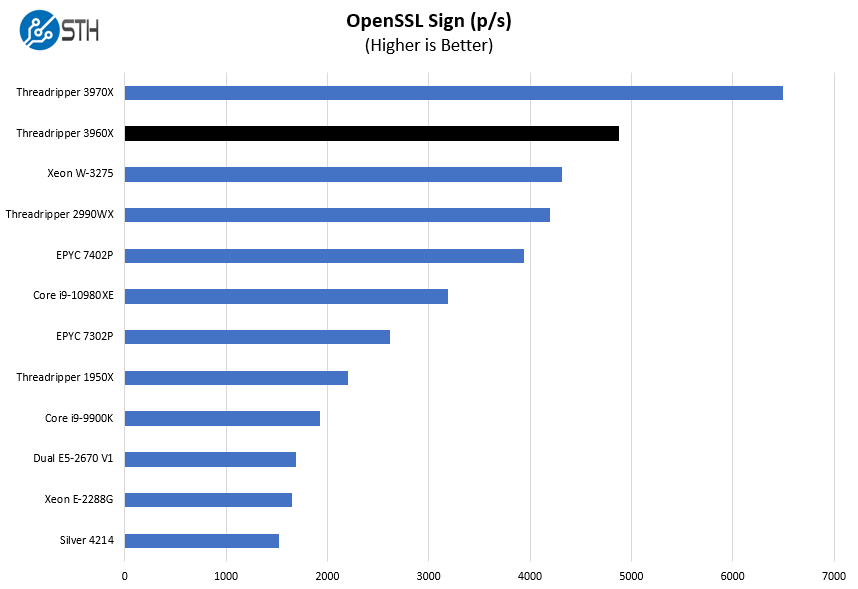
Here are the verify results:

Even with a core count deficit, the Threadripper 3960X at $1400 is able to outpace the $4449 Intel Xeon W-3275. That is a huge deal. Intel needs to re-position its stack from a competitive perspective if it wants to compete on performance and not just memory capacity.
UnixBench Dhrystone 2 and Whetstone Benchmarks
Some of the longest-running tests at STH are the venerable UnixBench 5.1.3 Dhrystone 2 and Whetstone results. They are certainly aging, however, we constantly get requests for them, and many angry notes when we leave them out. UnixBench is widely used so we are including it in this data set. Here are the Dhrystone 2 results:

Here are the whetstone results:
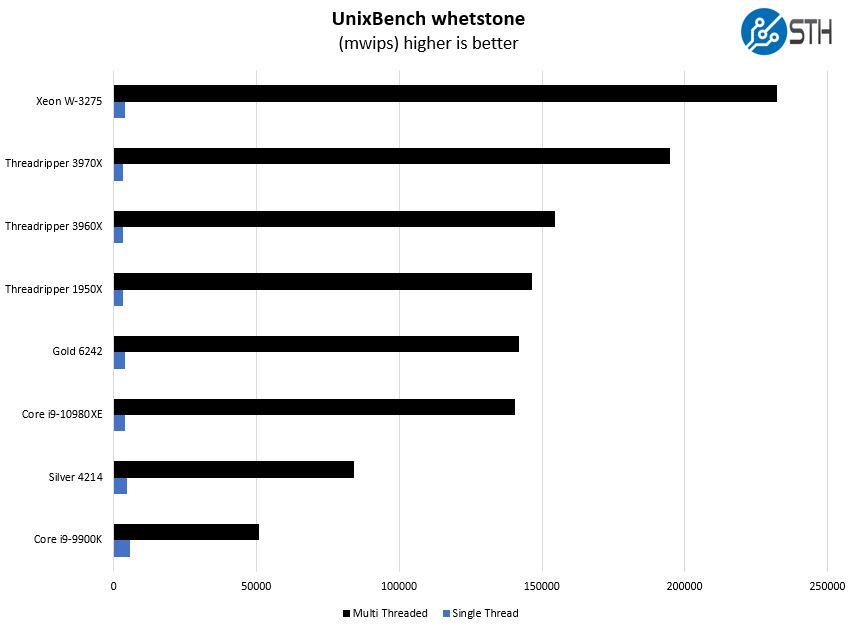
We added the dual Cavium ThunderX2 (2x 32 core) results here on the integer side to show how fast the new AMD chips are compared to a leading (shipping in market today) Arm solution. Here the ThunderX2 is closer to the 3970X but that puts the higher-power dual CPU solution between that 32 core part and the 3960X 24-core part. Arm performance is going to rise a lot in 2020 and into 2021 so this will change. We still wanted to show off what it can do.
Chess Benchmarking
Chess is an interesting use case since it has almost unlimited complexity. Over the years, we have received a number of requests to bring back chess benchmarking. We have been profiling systems and are ready to start sharing results:
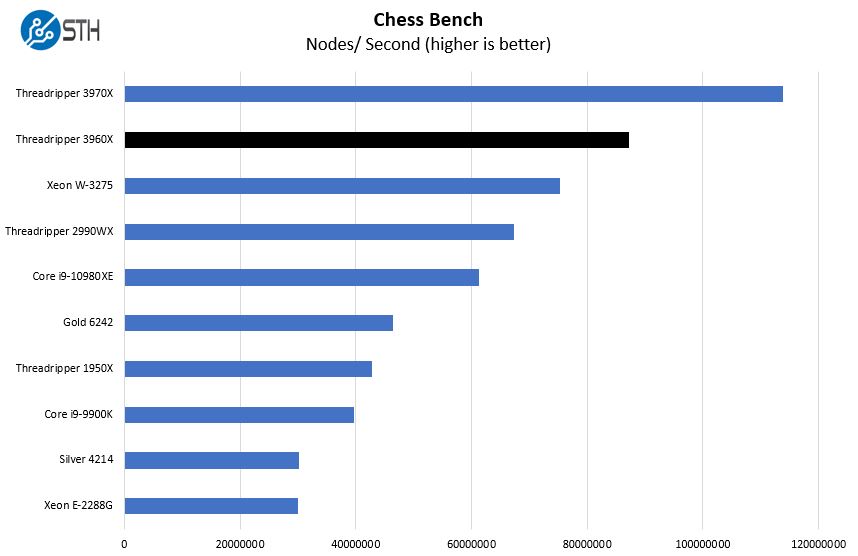
On the chess side, we again see Threadripper 3960X perform extremely well. That should be no surprise at this point.
Next, we are going to look at the power consumption before getting to our final thoughts.

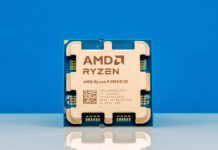

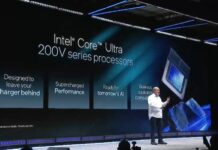
I’m hoping they’ll make RDIMMs available for the higher core count Threadrippers. I believe that the 32GB UDIMMs max out at 2666 mHz, so if you want 3200 you’re limited to 128GB. That’s not a lot to feed 128 vcores.
Ryan, have you encountered SCALEMP?
They are the OEM of Intel Optane RAM impersonation drivers.
Grab the most consistently low latency drive you can and go.
Would be great if you can test some of W-22xx family too. I’m most curious if their 165W TDP is a real thing as is in case of TR (which is on 280W these days) or this is just Intel and things go way up over that limit too like i9.
Hi KarelG – we are working on that.
Fully vetted/certified ECC(All Kinds) support is maybe not going to be provided for TR/Consumer parts by AMD/Motherboard makers and most of the Pro Software packages that really need either Epyc/Xeon branded parts.
If AMD creates a Pro Threadripper/MB True Workstation Branding it’s going to have to cost similar to the 7H02 series parts and AMD’s EEE division that’s currently over Epyc/Professional systems will not want any product segment cannibalization. That said if the TR 3000 series 48 and 64 core parts were limited to say 6 memory channels max and some more limited PCIe 4.0 lane counts compared to Epyc/SP3 then maybe that could be offered, but that’s without the full ECC memory types support where AMD/MB vendors spend extra on the proper CPU/MB certification/vetting process that does not come cheaply.
In not very many more business quarters AMD’s Epyc CPU/Pro GPU Accelerator sales will begin the process of dwarfing AMD’s consumer divisions in the revenue category and AMD’s golden cow will most certainly come from Professional Compute/AI and Server/HPC market revenues where the margins are there and most will pay and write that expense down on their taxes. AMD will have to be more like Intel in that regard in order for AMD to get the revenue stream going to compete with Intel longer term. So AMD has to push its gross margins ever higher or Intel will eat them on the R&D investment side.
It’s just too unfeasible for AMD/Pro MB partners to pack the full Professional feature sets into any consumer branded/priced parts and lose that needed gross margin and revenue growth that’s necessary to compete with the giant Intel empire. AMD maybe has another 2 years at most to get its market cap and revenues high enough to fend off Intel after that time frame expires and Intel’s proper reply has been fielded. AMD really needs to remain as active as a garden shrew on the R&D side of things and that’s going to need higher margins to fund.
@DiscoShrewzRevenuez
With its current product lineup, AMD is leaving a couple of gaps open, for Intel to have SKUs that have no direct competitor.
The first is the strange decision to not have a 16 core TR 3000 part. AMD claims that TR demand is top heavy, but still. This leaves open a gap for the 14 and 18 core X299 parts to fit in, for those who need more memory capacity, more memory bandwidth or more PCI-E lanes than what AM4 can provide.
The second, IMO more significant oversight is not competing with the Xeon-W lineup, which brings both high clockspeeds and tons of ECC RAM to the table, *at the same time*.
EPYC cannot compete with Xeon-W, because there are no frequency-optimized Rome parts.
TR cannot compete because it does not support ECC (L)RDIMMs.
Maybe the rumored TRX80 platform will be the Xeon-W competitor? With 8 channels of (L)RDIMMs?
@Anon: I somewhat agree about your first point – I got a TR1920X as a cheap entry into a terrific platform (little did I know that it will taken behind the barn and shot at first chance). But it’s much less important than your second point, that I totally agree with.
Even if they put out a higher tier TR with 8 channel RDIMM support as is rumored, they are in a tight spot. It’s really disqueting to see how quickly AMD adopts Intel’s artificial segmentation behavior once they are in the lead. In my opinion, the current TR3 platform doesn’t offer substantial advantages over the first TR platform but the price is huge (at least in terms of mindshare) – breaking compatibility. It should have had 96 PCIe lanes and 4 channel RDIMM support. Then it would have covered much wider set of use cases and would have provided real justification for the compatibility break. Now it’s just “meh” (with a lousy fan on top – I’m talking about the chipset obviously) while leaving a big market gap open.
BTW, I guess it’s not too late for AMD to offer frequency optimized Epyc. That would seal the gap from above.
Would be great if you could run the STH Linux benchmarks, especially the Kernel Builds per Hour.
Here we’re running lots of cross compilings to build embedded Kernels: Buildroot, Xilinx toolchain, Android toolchain, among others, make intensive use of X86 processors. Android build can last 3 hours on the Skylake family processors, even with a SSD. What can we expect from Threadripper ?
CyrIng – This is on page 5 of the review.
I really was hoping to hear more about the WRX80 Chipset for the TR3 by now. I would love to see a more Workstation oriented Chipset/Motherboard for the TR3. A Motherboard with express support for ECC Ram and also a few more PCIe slots and supports all TR3 chips.